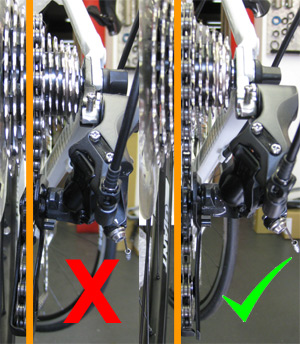Maintenance
Bicycles are machines and require continual maintenance to ensure performance is optimised, problems are avoided and component lifetimes are maximised. By spending a little bit of time caring for your bike and doing the right thing you will massively reduce the the overall time and cost spent fixing problems.
Here are a few tips to keep your bike in good condition.
Cleaning
The number one cause of premature component wear we see at Pedal On is over zealous cleaning. The seals on your bicycle are designed to keep out moisture and grit on the road or trail at natural pressures. The seals are not designed to protect your components from greater pressures than this because this would require a tighter seal which would create more friction, robbing energy and performance. Consequently, the use of jet washes and domestic hoses with a spray jet will compromise the seals of your bike and may lead to premature corrosion.
Most bicycle manufacturers recommend using only a mild detergent solution to wash your bike, this is to prevent the "good " grease being stripped from your bike. Strong detergents and aftermarket spray "bike cleaners" are indiscriminate and can work their way into seals removing grease where it is needed potentially causing premature component wear, squeaks and creeks. Aftermarket "bike cleaners" can also dull and damage paintwork.
Pedal On and its associate bike manufacturers recommend washing your bike using a mild detergent solution and a brush or sponge then rinsing with clean water. It is best to degrease the chain seperately using a chain cleaner.
Components which have been compromised or damaged by the use of pressure washers and "bike cleaners" will not be covered under warranty.
Chain Cleaning
Your bike's chain takes the most load of all components on your bike. By caring for it properly you can massively reduce drivetrain wear, optimise gear shifting and avoid problems such as chainsuck.
We recommend using a chain cleaner such as Park's CG2 to regularly degrease and clean your chain. In wet and dirty conditions this should be done every ride. In the dry, when less dirt is being picked up by the chain, this can be left a little longer.
(For chains featuring Shimano’s Sil-Tec coating (HG75, HG95, M981, HG600, HG700 and HG900) it is recommended to only clean the chain with warm soapy water, as powerful degreasers strip the low-friction coating.)
To protect your clean chain it is important to use the correct lubricant. In wet conditions this should be a heavier oil, we recommend Finish Line Wet lube. In dry conditions, you can use a lighter lubricant that isn't so sticky and doesn't pick up so much grime. We recommend Finish Line Dry lube for the dry. We do not recommend using "dry" lubricants in the wet as they get washed off very easily leaving an unlubricated chain.
We recommend applying chain lubricant from a drip bottle. Spray lubricants can easily contaminate disc brakes and rims.
Never, ever, use WD40 or GT85 to lubricate your chain these are too thin and offer no protection.
Seatpost Maintenance
When your frame is made the inside of the seatube is reemed to a precise diameter to fit your seatpost. As the fit is so important the inside of the seat tube is left bare which potentially means it could corrode and seize onto your seatpost.
This problem is easily remedied by periodically applying a layer of the correct type of barrier between the two surfaces.
If you have a carbon frame or carbon seatpost you should use a carbon prep gel, we recommend Finish Line Carbon Assembly Gel. Never use grease on a carbon component.
For aluminium frames with aluminium posts use an anti-seize compound or grease.
Suspension Maintenance
To maintain the best performance and to guard against premature wear, your suspension manufacturer (forks and shocks) recommend service intervals for their products. It is vital you follow these procedures to optimise your component's performance and to maintain its warranty.
In particular, it is vital you follow maintenance instructions to keep wiper seals clean and lubricated.
Please refer to your user manual for specific service intervals.
Check rear derailleur alignment
Your bicycle is most likely fitted with a breakaway gear hanger which is designed to fail in the event of a crash, therefore reducing the chance of damage to the bicycle's frame. By design, this part is relatively week and is vulnerable to misalignment. Misalignment of this part may cause your rear derailleur to catch the rear wheel and result in an accident or damage. It is imperative that the alignment of this part is checked as part of your pre ride checks, after storage, rear wheel removal, transportation and accidents. Your bicycle should never be stored with the rear derailleur leant against anything or sat on the rear derailleur with the rear wheel removed. The correct alignment for this part is for the rear derailleur cage to be in the same vertical plane as the rear wheel and not touching the spokes when in the large sprocket (low gear).

